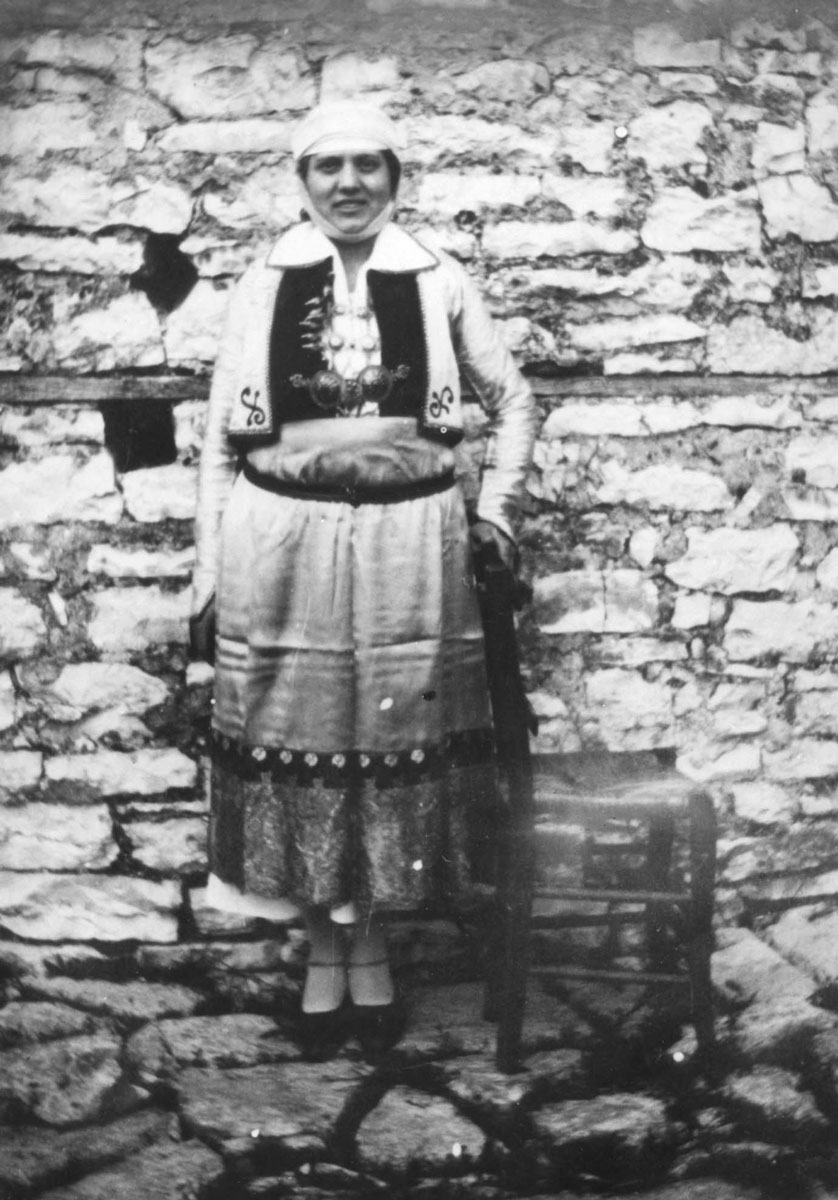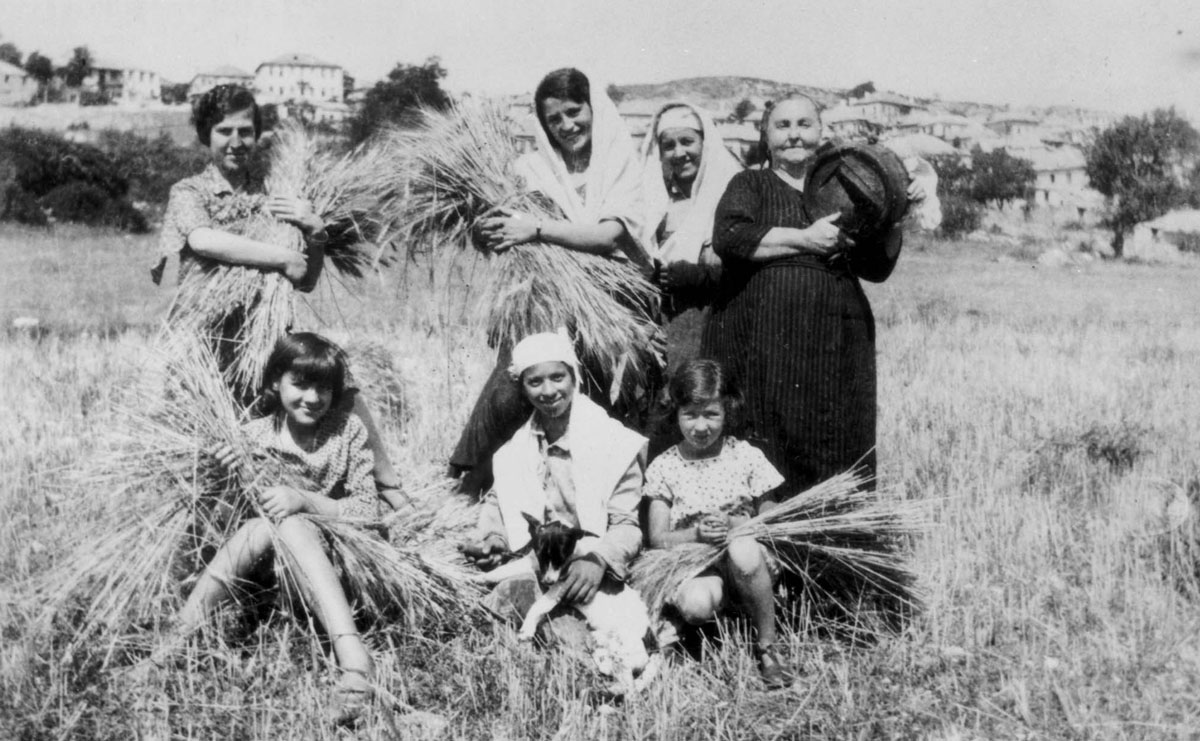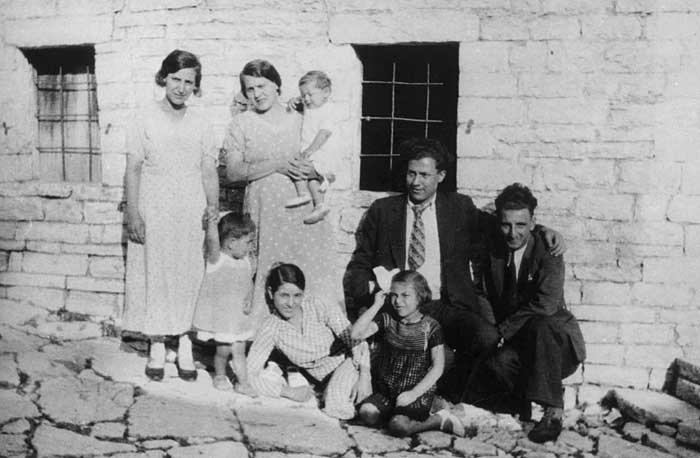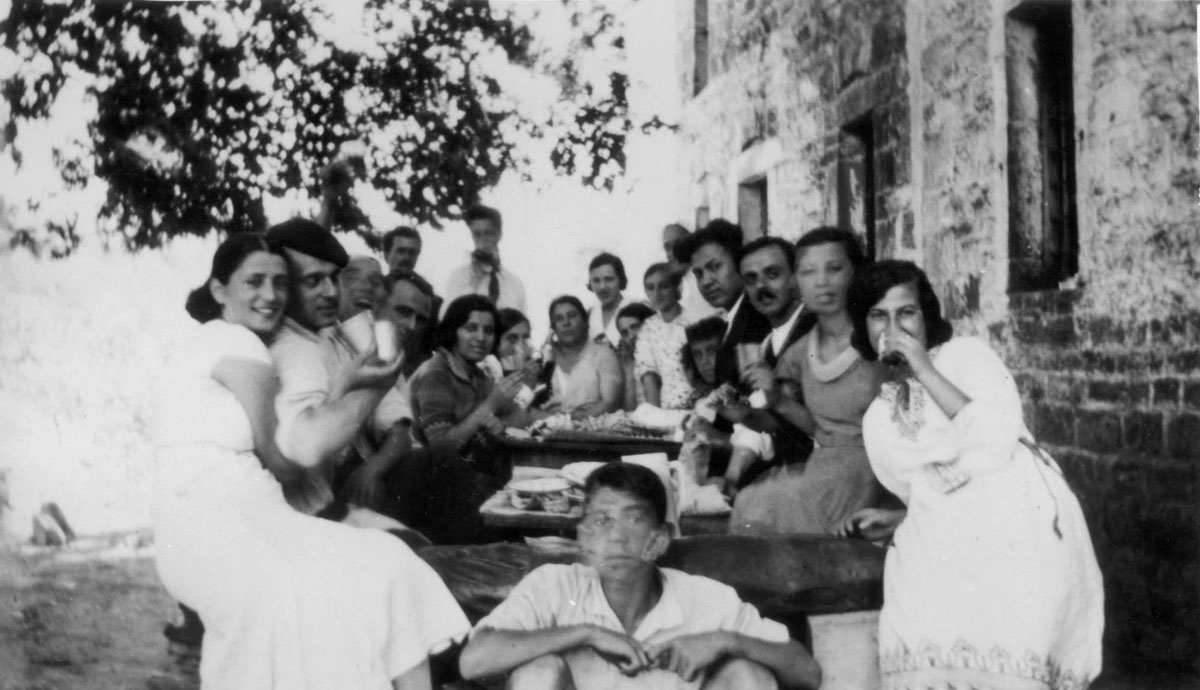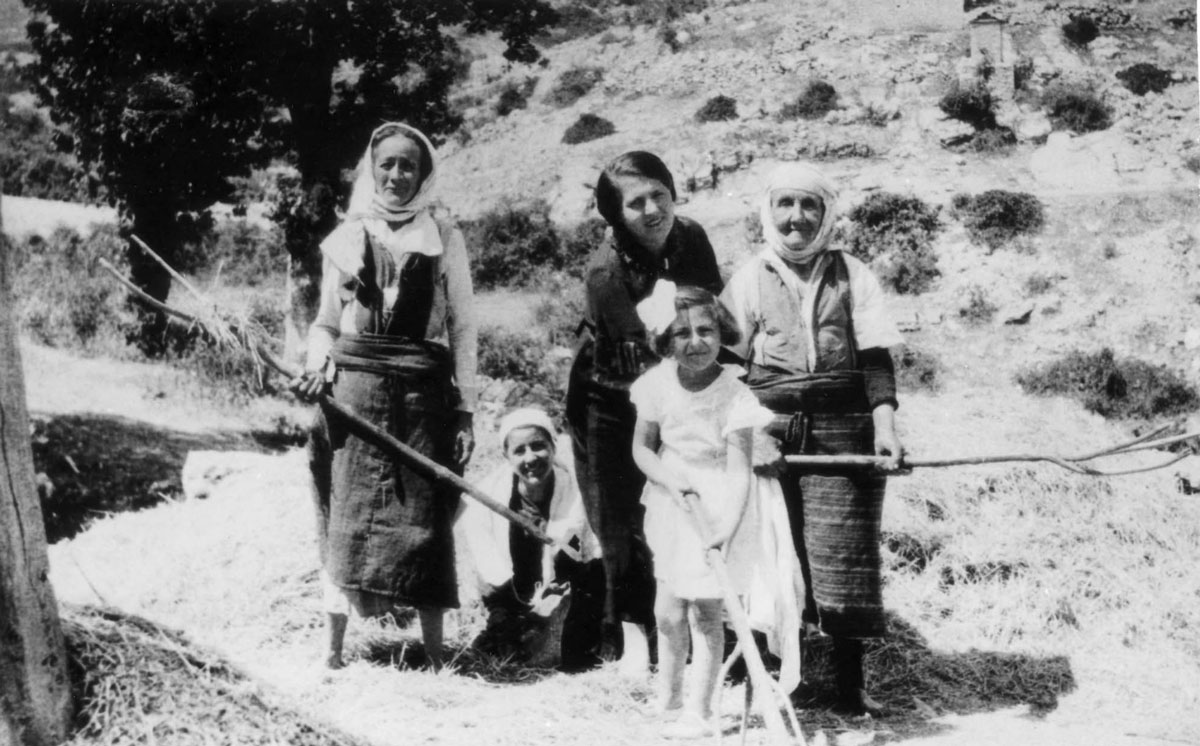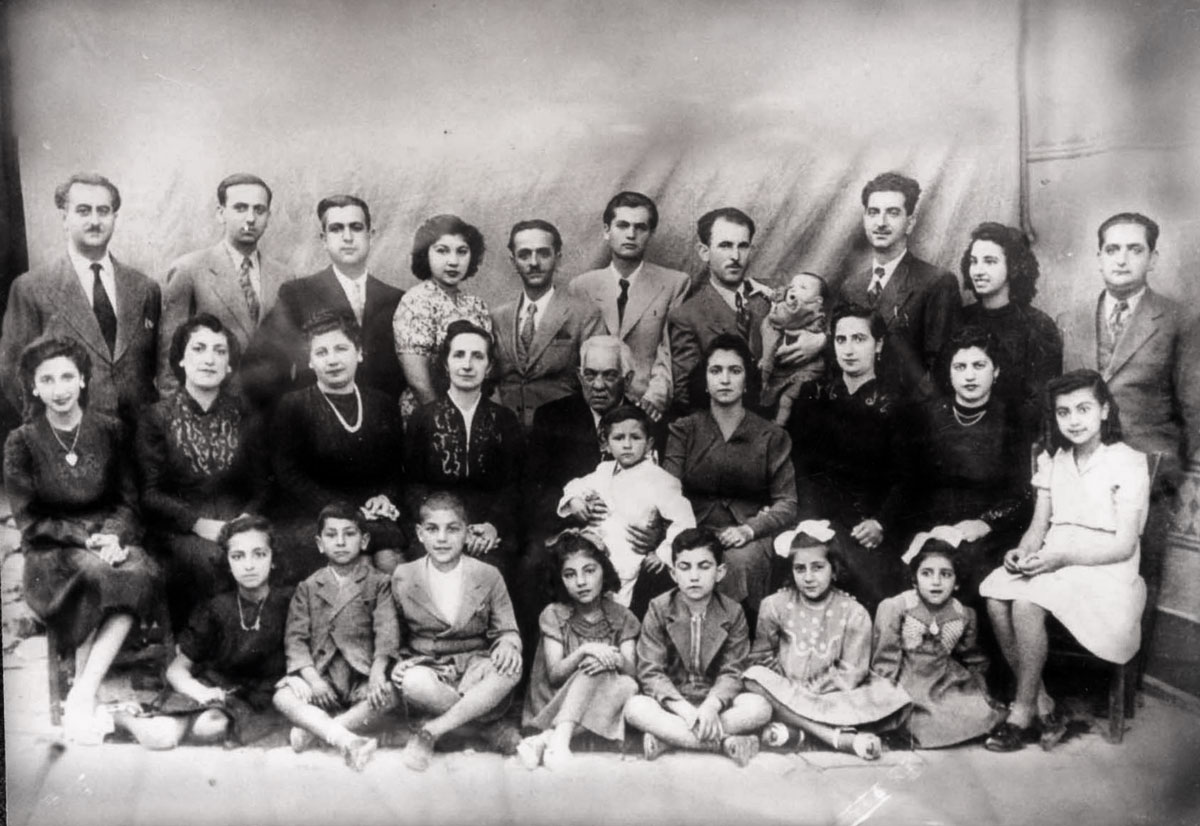- It is worth noting that the Greek name of the town of Ioannina has been transliterated into Yannina and is sometimes spelled, Janina.
- Sephardim are Jews originating in Spain or Portugal. The word “Sephardim” comes from the Hebrew word for Spain, Sepharad.
- Beginning in the Middle Ages, Jews who lived along the Rhine River in northern France and western Germany were known as Ashkenazim. The center of Ashkenazi Jewry later spread to Poland-Lithuania and after the Holocaust, spread all over the world.
- While this article focuses on the Romaniote community in Ioannina, Greece, it should be mentioned that there is also a history of Romaniote communities in Albania and Romania.
- Rae Dalven, The Jews of Ioannina, (Lycabettus Press: Greece, 1990).
- This refers to the Kehila Kedosha Janina Synagogue and community in New York City.
Introduction
My interest in the Jews of Ioannina began many years ago when I first read Nicholas Gage's book Eleni, which tells the tragic story of the murder of the author's mother in the village of Lia, in Northern Greece. In his book, Gage talks about the ancient Jewish community of nearby Ioannina, Greece, and their deportation to be murdered in March 1944. I was fascinated. I had never heard of these Romaniote Jews of Ioannina, nor of their ancient Jewish community, and sadly enough neither had most people I mentioned them to.
I decided that I could not let them be forgotten. I was very excited to learn that one of the very few survivors of Ioannina, a lovely lady called Artemis Batis Miron, often tells her story to student groups here at Yad Vashem. It was my privilege to interview her. Through her words, I hope to offer the reader a first-hand glimpse into that ancient community she lived in so long ago. To build a more complete picture of Jewish life in Ioannina, we have used photographs from Batis Miron's childhood and of Romaniote religious artifacts, generously lent to us by the Kehila Kedosha Janina in New York. Teachers can download and use these materials in the classroom in a special teacher's guide we have prepared.
A History of Jews from Ioannina, Greece
For two thousand years, Ioannina,1 a small city in northwest Greece, has been home to a very special Jewish community; a community of Jews who are neither Sephardim2 nor Ashkenazim,3 but rather “Romaniote” Jews. This branch of Judaism traces its roots back to the Roman Empire and these Jews are considered “Hellenized,” or Greek Jews. The Romaniote Jews adopted the language and customs of Greek civilization as their own, while at the same time maintaining their distinct Jewish identity, acculturating but not assimilating. In its conservatism and resilience to change, the Jewish community of Ioannina reflected the wider Christian community and northern region of Greece in which it existed. It is this quality which kept the community intact for so many centuries, for unlike the majority of other Romaniote communities in Greece, Ioannina’s Jews never became absorbed into the prevalent and much larger Sephardic community, adopting neither its liturgy and traditions, nor its language, Ladino. Over the course of two millennia and under different rulers and regimes, in periods of austerity and prosperity, the “Ioanninote” Jewish population existed, growing and shrinking in tandem with the prevailing political situation of the times. Never a wealthy community, the Ioanninote Jews made their livings mostly as merchants, tradesmen, and craftsmen. Theirs was a patriarchal society of arranged marriages, large families, and strict Jewish orthodoxy, where men were the community leaders and breadwinners, and women maintained the traditional roles of housekeeping and childrearing. On the eve of the Holocaust, the Jews of Ioannina numbered about two thousand. On March 25, 1944, 1,960 Jews of Ioannina – men, women, children, babies, and the elderly – were loaded onto trucks and deported to Auschwitz. Only two hundred returned.4
- 1. It is worth noting that the Greek name of the town of Ioannina has been transliterated into Yannina and is sometimes spelled, Janina.
- 2. Sephardim are Jews originating in Spain or Portugal. The word “Sephardim” comes from the Hebrew word for Spain, Sepharad.
- 3. Beginning in the Middle Ages, Jews who lived along the Rhine River in northern France and western Germany were known as Ashkenazim. The center of Ashkenazi Jewry later spread to Poland-Lithuania and after the Holocaust, spread all over the world.
- 4. While this article focuses on the Romaniote community in Ioannina, Greece, it should be mentioned that there is also a history of Romaniote communities in Albania and Romania.
Artemis Batis Miron: A Survivor from Ioannina
One of the survivors was a young woman named Artemis Batis (Miron). She was taken to Auschwitz-Birkenau at the age of fifteen, along with her family. Upon arrival, her mother, little brother, grandmother, and most of her extended family members were sent to the gas chambers. Artemis was taken into the camp for slave labor, eventually being forced out on a death march to the terrible camps of Ravensbrück and Malchow. In 1946, after her liberation, she made her way to Mandatory Palestine, where she married Yosef Miron. She has three children and many grandchildren. Today, she often tells young people her personal story of persecution under the Nazis and the tragedy of the Ioanninote Jews.
Today in Ioannina the Jewish community consists of only a small remnant of elderly people and sadly faces gradual extinction. A small group of Ioanninote immigrants and Holocaust survivors exists in Israel. In New York, the only Romaniote synagogue in the western hemisphere, Kehila Kedosha Janina, proudly carries on the traditions and legacy of the Romaniote Jews, both in the synagogue and in its accompanying museum.
For this article we turned to Marcia Haddad Ikonompoulos, museum director of the Kehila Kedosha Janina in New York, to offer a more historic glimpse into Jewish life in Ioannina as an accompaniment to the sixty-seven year old memories of Artemis Miron.
Interview with Survivor Artemis Miron
Within this interview we have included answers to questions we asked Marcia Haddad Ikonomopoulos, Museum Director, Kehila Kedosha Janina, New York, USA.
Life in Ioannina before World War II
For how many generations had they lived in Ioannina?
Artemis: All the generations of my family, as much as I can remember. I myself remember only my father and grandfather’s generation, but not more than that. I was only fifteen.
What did your family do in Greece?
Artemis: They were merchants. My grandfather had a business and he brought my father into the business, and they worked together.
If we are talking about a community that existed for two thousand years, what kept the Jewish community intact for that length of time?
Artemis: They didn’t know anything else. Their life was in Ioannina and they continued to live there while remaining Jewish. I want to tell you that outside of our homes there were no differences between the non-Jews and us. We didn’t live in a closed Jewish ghetto, we lived together with non-Jews, and even in our Jewish neighborhood, we had non-Jewish neighbors and we had good relations with them. We studied together in the same schools with the non-Jews, we spoke Greek like them, and we dressed like them. Outside our homes there were no differences between Jews and non-Jews pertaining to business, to neighborliness, to education - but in our homes, we strictly observed our Judaism.
Can you tell us a bit about Shabbat, or Jewish holidays in Ioannina?
Artemis: Every Shabbat I remember a non-Jewish man would come to our house to light the stoves for the heating. I remember my mother would prepare food for Shabbat that we would bring to the neighborhood’s public oven, and the man there knew that at one o’clock exactly, all the Jews would come to collect their food.
Remarks by Marcia
Can you tell us the significant differences, if any, in terms of religious customs, festivals, name giving, layout of the synagogue, women's roles, use of religious artifacts (Torah), between Sephardic Jews and the Romaniote Jews?
Marcia: To my knowledge, the Romaniote customs differ in the incorporation of piyyutim (liturgical poems) in a mixture of Greek and Hebrew and, in our synagogue, the order of the service is different from that of Sephardic Jews. Of course, our style of chanting is quite different. The differences in the celebration of holidays is best shown with the use of different foods. In my family (with roots in Salonika and southern Turkey), we ate rice at Pesach where Jews from Ioannina do not. As far as name giving is concerned, both groups (Romaniote and Sephardim in Greece) honor our mothers and fathers and name our children after them.
In a traditional Sephardic synagogue, the tevah (podium or bimah) is in the center and in a traditional Romaniote synagogue it is on the far western wall facing the ark with the Torah scrolls. In both communities the women do not say blessings over the Torah nor read from the Torah. In Greece, I understand there are now confirmation ceremonies (equivalent to a bat mitzvah) for girls but we here in New York at Kehila Kedosha Janina do not have this. We encase our Torah in tikkim (heavy metal and wooden cases) and do not remove them from the tikkim when carrying them up to the podium for reading.
Could you elaborate on burial traditions? Could you let us know about any specific engravings on the gravestones? Are they written in Greek or Hebrew or both?
Marcia: According to Rae Dalven (author of The Jews of Ioannina5) the body was wrapped in a shroud (which was made while the person was still alive) and buried without a coffin. The engravings on the tombstones in Ioannina are written mostly in Greek with very few written completely in Hebrew.
Artemis Miron nee Batish, the Holocaust survivor we interviewed here, told us that under Turkish rule, Romaniote Jews had a lot of freedom. However, she said that Jewish shops had to be open on Shabbat (the Sabbath) and students had to study on Shabbat. This was one of the reasons that many Ioanninote Jews left for Palestine, or joined the community in New York established in the 1920s. Could you elaborate on this?
Marcia: When Ioannina became part of modern Greece in 1913, under Christian rule, it was not that they had to keep their shops open on Shabbat but, rather, they had to close them on Sunday. If they chose to observe Shabbat and close their shops on Saturday, they had to pay non-Jewish workers for this lost day of pay and they would be at an economic disadvantage by having their shops closed on two days of the week (Saturday and Sunday).
- 5. Rae Dalven, The Jews of Ioannina, (Lycabettus Press: Greece, 1990).
Is this the synagogue you remember as a child?
Artemis: We didn’t pray in this synagogue; this synagogue was within the walls of the old city where there was also a Jewish neighborhood. Younger families such as ours lived in a newer neighborhood outside the old city and we prayed in the synagogue there. But that synagogue was totally destroyed by the Nazis.
What kind of house did you live in?
Artemis: We lived in a rented house, as my father put all of the money we had into the business.
Did your mother work outside the home?
Artemis: No, she was a housewife. Most of the women were, unless their financial situations required them to help support their family by working.
Did women study in university?
Artemis: No, because there wasn’t a local university. I want to tell you that the Alliance (school) only offered studies until fourth grade, but the level wasn’t high enough. In fourth grade, anyone who wanted to go to high school had to submit a formal request, and take a governmental test. If he passed that test, he went on to high school at the end of fourth grade. All of the rest of the students stayed in school just until sixth grade.
Were the Jews in Ioannina well educated?
Artemis: I think the Jews of Ioannnina were educated the same as anyone in our city. Look, there was no university in Ioannina. No colleges. Only those who were financially able to would send their children to higher education. They were a small minority - doctors or lawyers. They sent their children to study in Athens. When they completed their degrees, those educated children came back to serve in our community. The majority of Jews in our community were simple tradesmen and craftsmen.
Remarks by Marcia
Could you let us know if the Romaniote prayed in synagogue or at home in the special language called Yevanic?
Marcia: What is referred to as Yevanic was a mixture of Greek and Hebrew and was a liturgical language incorporated in the liturgy both in the synagogue and for celebrations at home.
Did you know Hebrew at all?
Artemis: No. We only repeated the Hebrew “aleph bet” like parrots… (laughs) But my grandfather, for example could read Hebrew and I think understood Hebrew as well, such as the Hebrew in the Passover Haggadah. We young people couldn’t understand the Hebrew, so next to the Hebrew text in the Haggadah, there was a Greek translation.
What language did you speak? Ashkenazi Jews spoke Yiddish, Sephardic Jews spoke Ladino, what language did Ioannina Jews speak?
Artemis: We only spoke Greek, but we had some dialects. For example, if a Jewish person was talking to a non-Jew, and another Jew wanted them to finish the conversation quickly or stop altogether, we’d use a Hebrew word with a Greek ending, which would mean “finish quickly.” Of course, we’d have to use a word that the person you were talking to wouldn’t understand, or they’d be insulted by the fact you were talking behind their back. So, if you wanted to tell someone to stop talking, or shut up, you could take a Hebrew word with a Greek ending! (laughs)
As a young girl, did you know anybody who had left for another country, such as America or Israel?
Artemis: I had a classmate whose father had left for Eretz Israel, with the hope that he would succeed and bring over his family. He didn’t bring his family over quick enough, and his whole family was caught and deported. She studied together with me in class; she survived and lives today in Tel Aviv.
Remarks by Marcia
What was the Romaniote community's connection with Palestine? Were there Zionist groups set up for the specific purpose of going to live in Palestine? Was there a large aliyah (immigration to Palestine)?
Marcia: As with other communities in Greece, the Romaniote community in Ioannina had a strong connection with Palestine. It was not uncommon for the elderly to go to Eretz Israel so they could die in Jerusalem. One of the main streets in the Jewish quarter was named after Max Nordau (a prominent Zionist and contemporary of Theodore Herzl) and there were families that made aliyah starting at the end of the 19th century.
Being a Romaniote Jew from Ioannina during the Holocaust and After
Artemis was deported to Auschwitz-Birkenau with her family. She was taken for slave labor and eventually marched out of the camp on a death march, finally reaching Ravenbruck and Malchow concentration camps. The rest of her family was murdered in the gas chambers.
Was there antisemitism in Ioannina?
Artemis: Listen – it would be a lie to say there was no antisemitism whatsoever but when you compare Ioannina with the antisemitism in Europe or Eastern Europe, there was zero antisemitism with us. Of course we felt in order to be accepted, we always had to be the best, to prove ourselves. But we were very acculturated into the Greek culture.
Can you tell me about the mayor of Ioannina, and what he did in the synagogue during the Holocaust?
Artemis: When the Germans entered Ioannina, he went into the synagogue, took out all of the contents, hid them, and promised when the Germans left he would replace everything. He purposely turned the synagogue into a temporary library, so that the Germans wouldn’t destroy it. And true to his word, when the Nazis left, he returned everything, all of the religious objects, to the synagogue exactly as they were, renovated the synagogue, and today there are twenty four pure white panels and on them, carved in black letters, are the names of the victims. So it’s exactly like it was plus these memorial plaques.
What motivated him to do this?
Artemis: He wanted to have a memorial to the Jews.
[ While Artemis had fond memories of the mayor, it was not he who actually put up the plaques in the synagogue. Marcia explained that the marble memorial plaques in the Ioannina synagogue were commissioned by two survivors. Makis Matsas and Leon Kabelis researched the names and raised the funds for the slabs, so that their community would be remembered. ]
Did being a Greek Romaniote Jew affect you in Auschwitz and the other camps?
Artemis: Don’t ask, because I'm so frustrated by this. I’m still angry. In the camps most of the women were Eastern European Jews and spoke Yiddish. Therefore, they didn’t recognize us as Jews because we spoke Greek, and I cannot tell you how humiliating that was. Worse than this, I was from a small Jewish minority in Ioannina and didn’t speak Ladino like the other Greek Sephardic Jews so I was doubly humiliated, also by the Yiddish speakers, and also by the Ladino speakers. They would say to me, “You aren’t Jewish.” At first they didn’t want to accept us as Jews. Slowly they accepted that we were Jewish, but that we couldn’t be observant Jews as we didn’t know any Yiddish at all, and after all, anyone who was observant had to have spoken Yiddish like they did at home.
How awful. You come from the oldest Jewish community in Europe!
Artemis: The oldest Jewish community and we were most humiliated. They finally understood that we were Jews, and we learned a few words in Yiddish, but we had no common language with them. We only learned enough Yiddish to understand impending dangerous situations such as a selection, but they had no other real connection with us. No heart to heart talks, no closeness.
When did you start telling your story?
Artemis: Only after 1990. I wasn’t able to tell anyone before that.
So your children didn’t know?
Artemis: My children didn’t know. They asked permission the first time to hear my story when I retired and came to Yad Vashem because I felt as if something was choking me, because it is impossible to close up such a traumatic event inside and never recall it again. How could such a thing be? And also, the yishuv in Eretz Israel didn’t see us in a good light, they saw us as having gone like sheep to the slaughter – why didn’t we fight back? Why did we just raise our hands and give up? They didn’t know how the German machine worked, how efficient, how organized it was. And they blamed us. And we were too embarrassed to speak… we kept silent all the time. Even Ben-Gurion (Israel's first prime minister) wanted to change these distinctly different Jews from the Diaspora, each with his own personal story, into the new Israeli type, into a homogenous Jew, and to erase their past. I tell you, every Jew who came here from the Holocaust has a story, whether he was in the Holocaust or not, if he was persecuted or not. You cannot erase a person’s past, even if his past isn’t a Holocaust one. Each one comes from his own culture, and has absorbed that culture into his being, and you come along and want to erase that? In an instant, you ask these people to forget the past and start a new chapter in their lives with no past? Can such a thing happen?
Arriving in Israel, all of these things were like blows to me. I left Greece to come to Israel, not because Greece wasn’t my home, but I had to leave, my whole family was murdered and no one was left there for me. I have to say I originally didn’t come because I was a Zionist, but gradually I became more of a Zionist than any other Jew.
When you came to Israel, to stay with your uncle Batis, did he ask what you went through?
Artemis: He knew.
Did you talk about it together?
Artemis: We didn’t really talk about it. He knew who had perished and he didn’t want to pry too much as he did not want to hurt me.
And how did you feel about it? Did you want to tell your story?
Artemis: No, only when I came to Yad Vashem, and started to tell my story and I cried. This really helped me because I met people at Yad Vashem who had gone through similar experiences, not always the same experience but very close, and I began to open up.
Do you have a connection with the Romaniote community in Jerusalem today? Is there one?
Artemis: Not really. So few remained.
Is there not a second generation, no continuity?
Artemis: Most of the Romaniote survivors live in Tel Aviv. I have some girlfriends that were with me in the camps, and until today I have a very deep and warm relationship with them, but only with them, and not their families.
So there is no continuation with the Romaniote traditions, Romaniote customs?
Artemis: No.
So it is a branch of Judaism that will…
Artemis: That will be erased, yes.
That’s very sad.
Artemis: Certainly.
Do they teach this legacy in schools?
Artemis: I don’t know, there was a period when people didn’t even know there was a Holocaust in Greece… only eastern Europe… at the most, people knew about the Jews in Saloniki, not in our community.
But there is still a Romaniote synagogue here in Jerusalem.
Artemis: Well, my cousin called me before Yom Kippur and told me that he gathered together a group of people with a connection to Ioannina, the children and grandchildren of Ioanniote Jews, some from Israel, some from Athens, about two hundred people, and he told me that they were going to Ioannina to observe Yom Kippur in the synagogue there.
How wonderful.
Artemis: I read that the synagogue in New York6 also celebrated a bar mitzvah there a few years ago, and that they also go to visit Ioanina every summer.
Artemis, if you wanted to say something about Ioannina to those who have never heard of the Romaniote Jews, what would it be?
Artemis: I would want to tell them about an ancient community that despite two thousand years of different regimes, rulers, and laws, managed to exist and observe its Jewish customs and traditions without assimilating, and for that, it deserves a prize.
- 6. This refers to the Kehila Kedosha Janina Synagogue and community in New York City.
Photographs
[Throughout this interview there have been photographs shown of Artemis and her family. She discusses one of them below.]
How were all of these photographs saved?
Artemis: They were here with my uncle. He had a collection of the family pictures and I copied them after the war.
I can see from these photographs that you went to the villages during holidays and lived with the local people.
Artemis: Yes. My grandfather wanted to give his son, my uncle Yitzhak, a treat when he would come back from Athens having worked and studied really hard, so he would send him off on a holiday… My Grandpa worried and wanted him to eat well. He had suddenly grown taller and skinnier as a student, and my grandfather wanted to return him to good health. So my grandfather sent him off to enjoy the outdoor country life and who would accompany my uncle? My grandfather’s eldest daughter, my mother. And she would take her kids along as well. My father would agree, and off we’d go. These women in the photo are the local peasants – very warm, very nice people. We’d be there for a month or so, and then return back to school.




